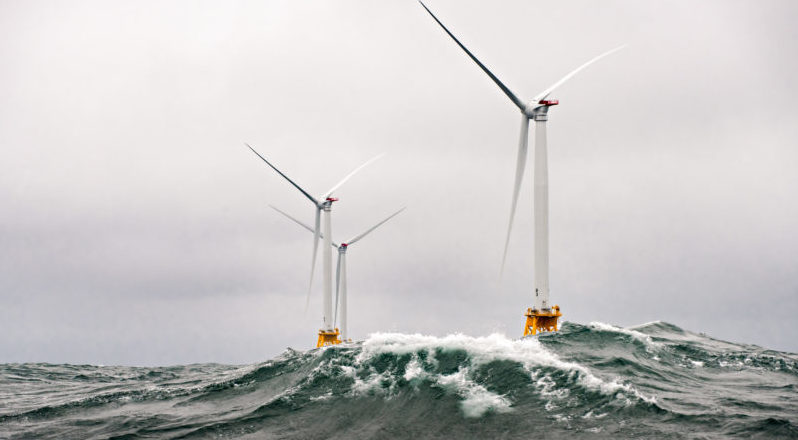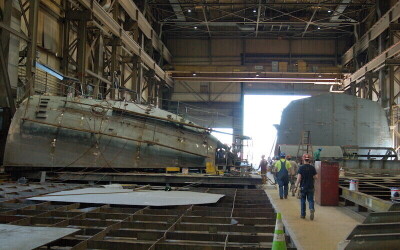Offshore wind power planners are coming to grips with potential user conflicts in the New York Bight, where state officials in New York and New Jersey want to develop vast arrays of wind turbines by 2030.
Nearly 6 gigawatts (GW) of power could potentially flow to shore from existing federal leases and additional areas on the continental shelf, under those ambitious plans. That would be roughly equivalent to nine first-generation commercial nuclear reactors like Oyster Creek in New Jersey, the nation's first commercial nuclear plant now scheduled for permanent shutdown by the end of 2018 after a half-century of operation.
Building that new energy infrastructure would overlay on some of the busiest waters along the U.S. East Coast, crisscrossed with shipping lanes, commercial fishing fleets and undersea cables.
A report by the New York State Energy Research and Development Authority already calls for making an early adjustment to the state’s proposed future wind energy areas (WEAs). That recommendation would take out a substantial chunk to ensure vessels have adequate sea room in the Ambrose to Hudson traffic separation lanes to and from New York Harbor.

State energy planners recommend reducing proposed wind farm areas to allow more sea room for shipping off New York. NYSERDA image.
It is just one of what will be many modifications, as the Bureau of Ocean Energy Management weighs state requests to offer up more lease areas off the power-hungry mid-Atlantic urban corridor.
So far, BOEM deems a buffer of one nautical mile between separation lanes and wind farms to be sufficient for navigational safety — a standard common to European offshore wind installations, the NYSERDA report notes.
But another Coast Guard appraisal looks for two nautical miles as a buffer. That will be a likely point of debate with the recent arrival of 1,200’ neo-Panamax containerships into New York and other East Coast ports.
“It is difficult to apply a standardized minimum distance between wind farms and navigation routes, as risks will vary depending on the location, proximity of turbines to a route boundary, prevailing metocean (meteorological and ocean) conditions, and existing and future vessel traffic profiles,” the report says.
To develop its plans further NYSERDA will rely heavily on four technical working groups with advisors on environmental, maritime, fishing and wind power supply chain issues, said Greg Lampman, NYSERDA’s environmental research program manager.
In 2018 New York will put out its first requests for proposals (RFPs) for energy from wind power, and state officials expect they will get up to six offerings from wind developers who already have federal leases, including those off New Jersey and southern New England.
Meanwhile, those developers who are farther along, like Rhode Island-based Deepwater Wind, are contending with resistance from the commercial fishing industry. Representatives from Deepwater, Vineyard Wind, Bay State Wind and BOEM sat Feb. 12 for a parley with skeptical fishermen in New Bedford, Mass., a fishing port that state officials also hope will be a hub for developing offshore wind energy.
Rodney Avila, a prominent figure in the New Bedford fishing community and a former member of the New England Fishery Management Council, joined Deepwater as the company’s fisheries liaison, working out of its New Bedford office.
Wind developers could have more success persuading the recreational fishing industry they can co-exist. On Wednesday the American Wind Energy Association released a video, produced by the Special Initiative on Offshore Wind at the University of Delaware, that shows the colonization of Deepwater’s Block Island Wind Farm by blue mussels and other marine life that attract fish.
Before the turbine foundations were installed in summer 2016, “it was pretty much an unfished piece of ocean,” said Chris Hobe, operator of Fish the World Charters, whose Block Island company has a new business line taking customers of tours of the wind farm.
The five-turbine, 30 MW Block Island project is the first commercial U.S. offshore wind farm and a test site for the first ongoing studies of how those installations may affect fisheries.
So far gill net fishermen and operators of mobile gear like trawls and lobster trap lines have been able to work in the half-mile gaps between the towers, said Aileen Kenney, Deepwater’s vice president for permitting and environmental affairs. The company’s planned 15-turbine, 90 MW South Fork project east of Long Island will have a larger footprint to allow more sea room for bigger fishing vessels with mobile gear, she said.





